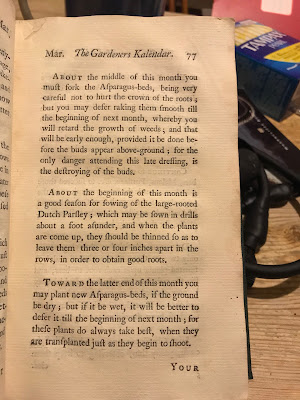 |
| Philip Miller |
A few years ago I was visiting a local bookseller's and noticed a small disbound volume stashed high up on the shelf near his counter. As soon as I held it in my hands and saw its title page I knew that (a) I had to have this one, and (b) I would bring it 'back to life' by getting it rebound. So I did!
What I had acquired was an early eighteenth century planting calender written by the Head Gardener of what was once 'The London Apothocary Garden' (still going, but now named, 'The Chelsea Physic Garden'). Like many of you, I have been spending more time in my garden, and have gained great enjoyment pottering about and observing, with anticipation, the buds about to burst into blossom.
This reminded me of the little book I had purchased and 'revived' and so, today, I sat in the sunshine and read through Miller's entries for March. Now, whilst I have a small suburban garden, the London Apothocary Garden was on another scale altogether and by the time of its writing was bursting with plants from all parts of the planet, gathered in the wake of Britain's imperial expansion.
I am sure that Norwich once had similar gardens; for instance, that owned by Sir Thomas Browne just beyond the cathedral precinct during the seventeenth century would surely have been brimming with a diverse range of plants - almost an outdoors horticultural 'cabinet of curiosities' no doubt. The city had a strong tradition of gardens and gardening; not least, those owned by the medieval Cathedral, stocked for, both, food and herbal medicines. This tradition recieved another injection of energy with the coming of 'The Strangers' to Norwich in the second half of the sixteenth century. The Dutch, Flemish and Walloon refugees all brought with them a keen interest in cultivation - not least, in the form of a fascination with tulips. It is no coincidence that, by the seventeenth century, the city held regular flower festivals. In the middle of that century, the clergyman and antiquarian, Thomas Fuller, described the city in his 'Worthies of England' (1662):
'Norwich is (as you please) either a city in an orchard, or an orchard in a city, so equally are the houses and trees blended within it.'
Anyway, my point is that, as we potter in our gardens we are part of a long tradition. But what of that early eighteenth century London Apothocary Garden? Well, the pages of Miller's Kalendar are teeming with an amazing diversity of planting - too diverse to describe here. So instead, perhaps it is best to just show you a few pages so that you can read it for yourself. We'll start with the preface and then look at the first few pages for the month of March...









No comments:
Post a Comment